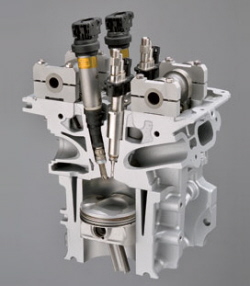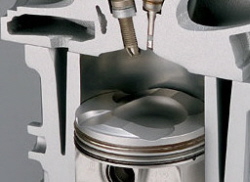Automobile Magazine recently recognized stability control as its “technology of the year.” As much as I value this feature, the award confuses me, as stability control has been widely available for a few years. I’d have given the award to direct injection instead.
 What is direct injection? In conventional gasoline engines, fuel is injected into the intake runner behind the valve, not directly into the cylinder. With direct injection, fuel is injected directly into the cylinder relatively late in the compression stroke. This was not done earlier because it requires much higher fuel line pressures, over 2,000 pounds per square inch (psi) vs. about 40 psi with conventional fuel injection.
What is direct injection? In conventional gasoline engines, fuel is injected into the intake runner behind the valve, not directly into the cylinder. With direct injection, fuel is injected directly into the cylinder relatively late in the compression stroke. This was not done earlier because it requires much higher fuel line pressures, over 2,000 pounds per square inch (psi) vs. about 40 psi with conventional fuel injection.
Direct benefits include a more even fuel-air mixture and a cooling effect inside the cylinder. As a result, it’s possible to compress the mixture more without risking premature detonation. Compression ratios for direct injected engines tend to be about 12:1 without boost from a turbocharger or supercharger, and about 10:1 with it. Both numbers are about 1.5:1 higher than conventional engines.
 Why does this matter? Well, owing to the higher compression and the more even mixture, direct injection engines produce more power AND get better fuel economy. Taken to the extreme, we get the new Lexus LS, which earns EPA ratings of 19 city and 27 highway despite weighing in at over 4,200 pounds and being powered by a 380-horsepower 4.6-liter V8. The previous LS earned slightly lower ratings despite weighing a couple hundred pounds less and having 102 fewer horses under the hood. Similarly, VW’s GTI and GLI with their 200-horse turbo four and nifty DSG transmission earn ratings of 25 city and 31 highway.
Why does this matter? Well, owing to the higher compression and the more even mixture, direct injection engines produce more power AND get better fuel economy. Taken to the extreme, we get the new Lexus LS, which earns EPA ratings of 19 city and 27 highway despite weighing in at over 4,200 pounds and being powered by a 380-horsepower 4.6-liter V8. The previous LS earned slightly lower ratings despite weighing a couple hundred pounds less and having 102 fewer horses under the hood. Similarly, VW’s GTI and GLI with their 200-horse turbo four and nifty DSG transmission earn ratings of 25 city and 31 highway.
Only in the 2006 model year did direct injection become available in the United States in more than one or two models, and it remains far from common. But it should spread quickly over the next few years, and I suspect that in five years the majority of gasoline-powered cars will have it. So you can probably look forward to more power and better fuel economy in your next ride.